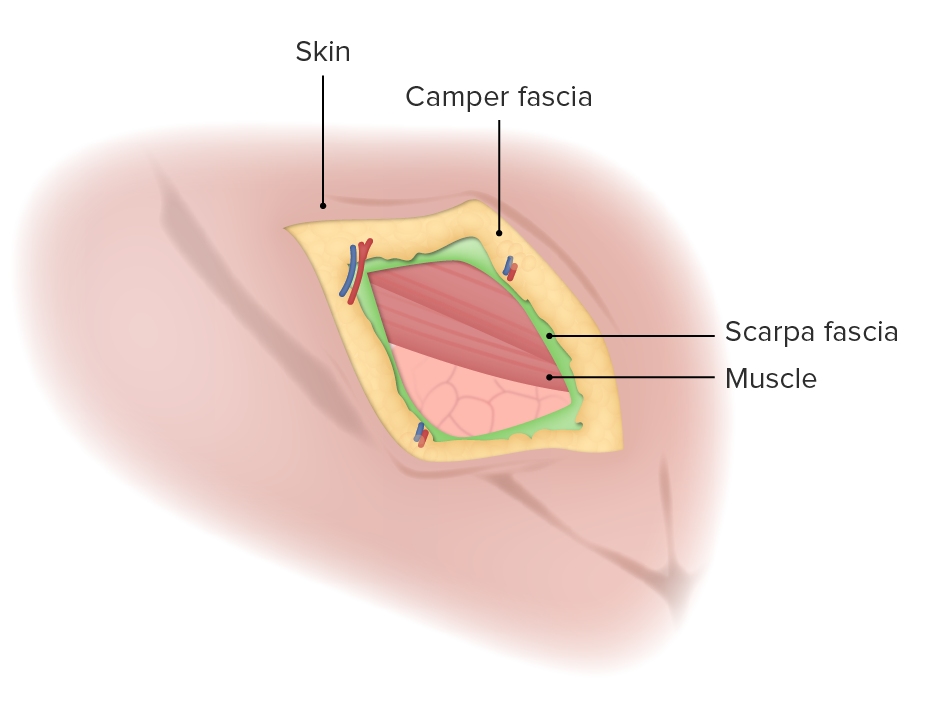Playlist
Show Playlist
Hide Playlist
Dermatomes of the Abdomen
-
Slides Dermatomes of the Abdomen.pdf
-
Reference List Anatomy.pdf
-
Download Lecture Overview
00:01 So now we're familiar with some of the organs that can be palpated through the surface of the anterior lateral abdominal wall. 00:07 It's important just to very briefly recognize dermatomes, and also some aspects of referred pain. 00:13 Now, this can be quite detailed the mechanism of referred pain. 00:16 So, we won't touch on that for the time being. 00:19 But briefly, if we just remember the innovation of the anterior abdominal wall, or through various somatic nerves that are coming from the spinal cord, and running from each spinal cord segments around the abdomen to form these bands. 00:34 So we can see that approximately the level of the umbilicus, we have the 10th somatic nerve, spinal nerve that's coming from the spinal cord. 00:43 And then above it, we can see T9, T8, T7, T6. 00:47 So these are the spinal nerves coming from the spinal cord and their appropriate spinal cord segment. 00:53 Giving rise to those nerves, those spinal nerves that run around the abdomen piercing through various abdominal wall muscles, which we'll come to in a later lecture. 01:03 And you can see that approximately, we have T6 running kind of from the xiphoid sternum and T7, all the way through down to T10, at the umbilicus, and then T12, and around L1 at the pubic symphysis level. 01:17 These are really important because when we talk about referred pain, there can be some confusion between is it actually pain or sensation coming from the surface of the skin to touch or wherever it's actually coming from an organ that situated deep to the skin. 01:34 So here we can see the stomach may have pain coming from this region. 01:38 But the way the stomach is innovated by the various neuro structures, can actually radiate to the central nervous system as if pain is coming from that part of the body wall. 01:49 So someone may say they have pain from a certain aspect of the body wall. 01:53 But it's not actually a problem with the skin or the subcutaneous tissue. 01:57 It's actually problem with the organs that are situated perhaps not directly beneath that area that's alluding to that pain. 02:06 So here we can see pain radiating in these regions may be coming from the stomach. 02:11 Pain from this region may be coming from the head of the pancreas, or the duodenum. 02:17 Pain in this region may be coming from the spleen, the gallbladder, the liver, the small intestines, and the large intestine, kidney and the ureter. 02:27 And you can see how actually, the position of this pain that's radiating from the organ, relates not necessarily to the location of where that organ is within the abdomen. 02:38 And that's important to recognize. 02:40 Because as future doctors, if someone comes to see with pain coming from a certain region, it could be that it's coming from the surface of the skin or subcutaneous tissue, or it could be being referred from an organ that lies underneath the skin within the abdominal cavity. 02:57 So thanks very much for listening. I hope you enjoyed this topic.
About the Lecture
The lecture Dermatomes of the Abdomen by James Pickering, PhD is from the course Surface Anatomy of the Abdomen.
Included Quiz Questions
Which spinal nerve is at the level of the umbilicus?
- T10
- T9
- T12
- L1
- L3
Which type(s) of nerves innervate the abdominal wall?
- Somatic nerves
- Sympathetic nerves
- Parasympathetic nerves
- Sympathetic and parasympathetic nerves
- Somatic and sympathetic nerves
Customer reviews
5,0 of 5 stars
| 5 Stars |
|
1 |
| 4 Stars |
|
0 |
| 3 Stars |
|
0 |
| 2 Stars |
|
0 |
| 1 Star |
|
0 |
Very well explained! As usual :) I was watching Dr. Pickering's lectures when I was in Premed School and everything was so blurry for me... Now I'm doing my clinical rotation and I need a refresh of info. It was a nice surprise to discover the new format of Anatomy lectures, but I'm also happy that you kept the old version archived. Thank you very much!!




